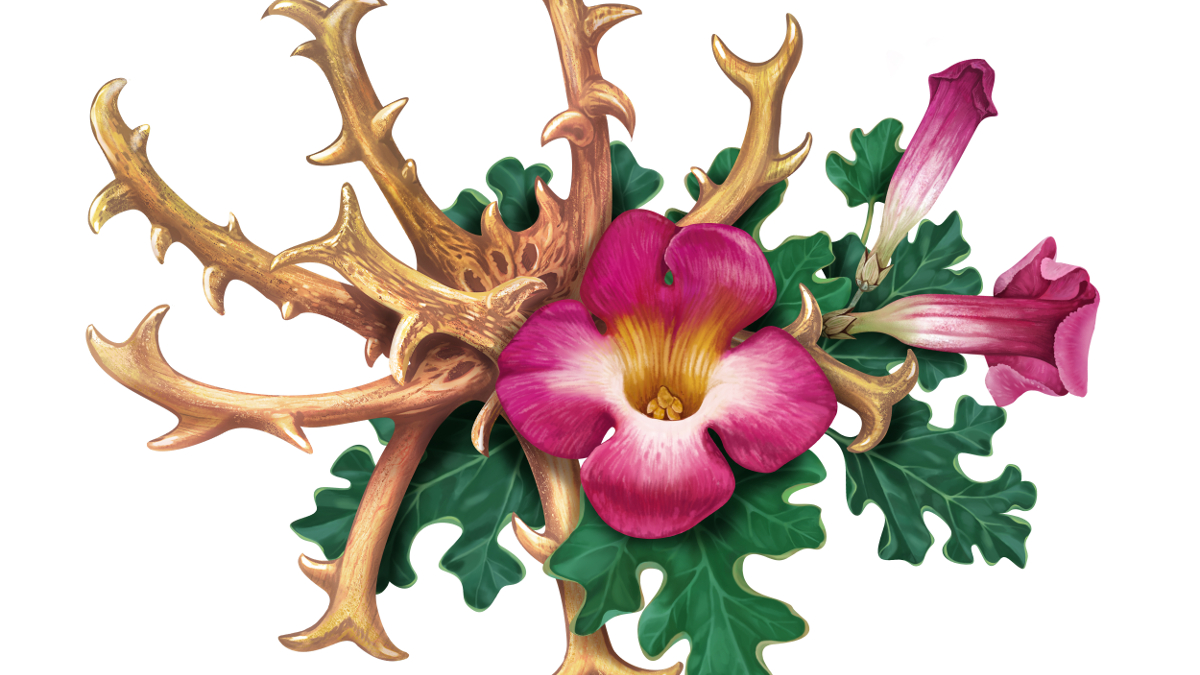
What exactly is Harpagophytum?
This somewhat complex-sounding plant is better known as ‘devil’s claw’ or ‘grapple plant’. Part of the Pedaliaceae or sesame family, Harpagophytum South Africa and Madagascar.
The proven benefits of the plant come from its deep roots which contain calcium, iron, copper, vitamin C, vitamin A, and potassium along with many other active ingredients.
A plant recognised for maintaining good joint health
First and foremost, several clinical trials have shown that Harpagophytum supports healthy joint function (1). Remarkably, a comparative study of 122 subjects suggests that devil’s claw is almost as effective as a drug used to treat osteoarthritis (diacerein) (2-3).
Similarly, a two-month UK trial of 259 patients found that taking Harpagophytum resulted in a significant reduction in joint discomfort (4). Indeed, ESCOP, (the European Scientific Cooperative on Phytotherapy) recommends taking devil’s claw to help maintain joint health and flexibility.
This plant is also believed to ease discomfort in the lower back (5-6).
Harpagophytum may help to stimulate both appetite… and the feeling of satiety
It has also been suggested that Harpagophytum helps to restore appetite… as well as increase the sensation of satiety. This may be due to its potential interaction with the hunger hormone (7).
One study showed that mice given powdered devil’s claw tended to eat less food than those given a placebo (8). Harpagophytum is thus sometimes used to support weight management and even to prevent obesity (9).
Devil’s claw may play a role in ensuring a healthy digestive system
Bid farewell to constipation, diarrhoea and flatulence! Clinical trials suggest that extracts of devil’s claw may significantly reduce - and even eliminate - digestive discomfort (10). It may thus help improve digestion and facilitate healthy elimination of waste products.
Harpagophytum may improve nutrient absorption in the gut, too. It is also traditionally used to help reduce cholesterol (11). Last but not least, devil’s claw may also have antioxidant properties, and may therefore contribute to delayed ageing of cells (12).
Some supplements formulated to support joint health
Is your quality of life adversely affected by joint or muscle pain? Are you keen to find effective, natural relief? Then try Super Harpagophytum. This natural dietary supplement will help to both maintain the health of your joints and combat oxidative stress.
In addition, you could combine it with Super Boswellia. This Boswellia serrata supplement, standardised to 20% AKBA (its most active ingredient), also plays an active part in maintaining joint health.
You can, of course, always opt for a joint-specific formulation such as Joint Support Formula, which combines chondroitin and marine-source glucosamine.
Note: there are, however, certain contraindications for this supplement. Those suffering from diabetes, high blood pressure, stomach ulcers or gallstones should not take Harpagophytum. The same applies to women who are pregnant or breastfeeding.
References
- Devil's Claw (Harpagophytum procumbens) as a treatment for osteoarthritis: a review of efficacy and safety. Brien S, Lewith GT, McGregor G. J AlternComplement Med. 2006 Dec;12(10):981-93. Review.
- Chantre P, Cappelaere A, et al. Efficacy and tolerance of Harpagophytum procumbens versus diacerhein in treatment of osteoarthritis. Phytomedicine. 2000 Jun,7
- Efficacy and Tolerance of Harpagophytum Procumbens Versus Diacerhein in Treatment of Osteoarthritis, P Chantre 1, A Cappelaere, D Leblan, D Guedon, J Vandermander, B Fournie, 2000 Jun 7
- Effectiveness and safety of Devil's Claw tablets in patients with general rheumatic disorders Mary Warnock Douglas McBean Andreas Suter Jen Tan Patricia Whittaker 20 September 2007
- https://www.lombalgie.fr/comprendre/quelques-chiffres/
- Chrubasik S, Junck H, et al. Effectiveness of Harpagophytum extract WS 1531 in the treatment of exacerbation of low back pain: a randomized, placebo-controlled, double-blind study.Eur J Anaesthesiol 1999 Feb,16
- Devil's Claw to Suppress Appetite—Ghrelin Receptor Modulation Potential of a Harpagophytum procumbens Root Extract, Cristina Torres-Fuentes, Wessel F. Theeuwes, Michael K. McMullen, Anna K. McMullen, Timothy G. Dinan, John F. Cryan, and Harriët Schellekens, 2014 Jul 28.
- The Role of Leptin and Ghrelin in the Regulation of Food Intake and Body Weight in Humans: A Review, M D Klok, S Jakobsdottir, M L Drent, 2007 Jan,8
- Devil's Claw to Suppress Appetite—Ghrelin Receptor Modulation Potential of a Harpagophytum procumbens Root Extract, Cristina Torres-Fuentes, Wessel F. Theeuwes, Michael K. McMullen , Anna K. McMullen, Timothy G. Dinan , John F. Cryan, and Harriët Schellekens, 2014 Jul 28.
- European Scientific Cooperative on Phytotherapy (Ed). Harpagophyti radix, ESCOP Monographs on the Medicinal Uses of Plants Drugs, Centre for Complementary Health Studies, Université d'Exeter, Grande-Bretagne, 1996.
- Sécurité des patients et protection des plantes médicinales : lignes directrices destinées à une industrie qui vaut 60 milliards de dollars, 10 FÉVRIER 2004
- Antioxidant Activity and Bioactive Constituents of the Aerial Parts of Harpagophytum Procumbens Plants, 15 Apr 2014
5 Days
Delivery is prompt and I never saw a…
Delivery is prompt and I never saw a quality problem with the manufacturing. It is not possible to assess efficacy on a personal basis, since too many factors come into play. Efficacy can only be assessed statistically with a sufficient number of cases.
Roger De Backer
6 Days
I collaborates with the Supersmart…
I collaborates with the Supersmart more than 10 years. Every thing is going good. Quality of the things is good. Delivery comes in time. Five stars definitely !!!
Oleksiy
6 Days
All good
Simple, frictionless site, easy ordering, good delivery updates and execution.
Chris Robbins
8 Days
I feel better
I feel better
Peter Ammann
8 Days
Prompt delivery
Prompt delivery
JAKUB Radisch
9 Days
My new go-to for top quality supplements!
I am buying more and more of my supplements from this superb, high quality company. Cannot recommend it enough. Plus, excellent customer service with a quick, helpful team and speedy deliveries. Highly recommend Supersmart!
Cecilie H.
13 Days
SUPERSMART WHAT ELSE👍
SUPERSMART WHAT ELSE👍
DIEDERLE Christophe
16 Days
Excellent quality products with…
Excellent quality products with innovative formulas, as someone who has been suffering with acid reflux, these supplements have been lifesavers.
Oriana Moniz
16 Days
high quality supplement!
high quality supplement!
GALANT
17 Days
Good service prompt delivery
Good service prompt delivery
Mrs Marcella Reeves
21 Days
I like your clear explanation
I like your clear explanation. And how to make a choice of products for a specific health problem
Ingrid
28 Days
Great product and it arrives quickly.
Great product and it arrives quickly.
SOMMARIVA Gianni
29 Days
Excellent products and fast service.
Excellent products and fast service. What do we need more?
Margarida
33 Days
The variety of products is amazing
The variety of products is amazing, the offers are good and the sending is very fast. I just miss having a bit more of guidance about combinations, possible interactions, etc.
Maria Angeles Verdu
35 Days
It was quick
It was quick.
Timo Antero





